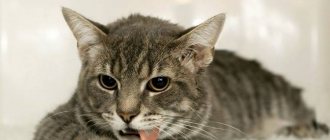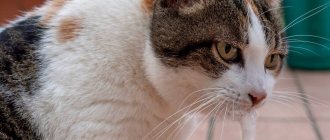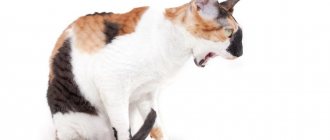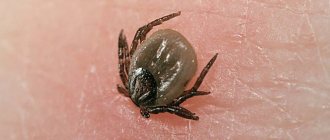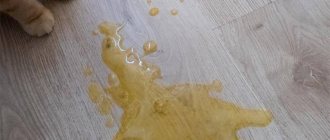Warning
: Invalid argument supplied for foreach() in
/home/shatkov/ourkoshki.ru/www/wp-content/plugins/custom-blocks/custom-blocks.php
on line People are accustomed to considering vomiting and nausea a sign of dysfunction of the digestive system. In cats, everything happens a little differently, and in some cases it is even considered a normal physiological process. Due to their natural cleanliness, cute fluffies constantly lick their fur coat, at the same time swallowing a certain amount of their fur.
This is one of the causes of the gag reflex, which should not cause undue concern. But there are other situations in which vomiting can become a symptom of a dangerous disease. We will look at these and other reasons in our article.
Why does my cat vomit white foam?
Vomiting in an animal is a kind of defensive reaction to the entry of chemical irritants, foreign objects and pathogenic bacteria into the body. A cat vomiting white foam may indicate a malfunction of the biliary system. During the digestion of food in the stomach and its entry into the intestines, the secretion of mucus does not stop, the excess amount of which turns into white bubbles upon contact with air. If in this case the foam has a uniform consistency and nothing is present in it, there is no danger to the cat’s body.
[custom_ads_shortcode1]
What does vomiting white foam mean?
Vomiting in cats occurs spontaneously. Poor quality food, excess food or liquid, foreign body, chemicals can become a signal for the gag reflex. The animal’s brain also activates vomiting due to more serious reasons - gastrointestinal pathologies, increased intracranial pressure, exposure to external factors, poisoning or the presence of worms.
Veterinarians consider white vomiting a universal symptom and recognize many diseases by it. Cat breeders should know about the causes of vomiting foam and white liquid, and be able to respond promptly and competently to what is happening.
The mechanism of the gastrointestinal tract of cats is similar to that of humans: the bolus of food enters the stomach and is digested there in a few hours. Next, the gastric contents follow into the intestines. In this case, a minimal amount of gastric juice and special mucus remain in the stomach to protect the walls from corrosion. Protective mucus consists of polysaccharides and proteins, which react with oxygen in the air to form a white foam. Therefore, if a cat vomits white foam, then this most likely happened on an empty stomach and without any aggravating factors.
© shutterstock
Causes of vomiting in kittens
The kitten vomits white foam in the following cases:
- A sharp transition from one diet to another (for example, the baby has just been weaned from his mother and has been fed full-fledged “adult” food, and his stomach has not yet learned to digest natural food or feed).
- Poor quality, unhealthy food (fatty, fried, salted, smoked, stale food and cheap low-quality food cause a negative reaction and rejection in the kitten).
- Overeating and eating too large pieces of food.
- Getting a large amount of hair into the stomach (with frequent and active licking).
- Accidental ingestion of foreign objects (candy wrapper, toy part, Christmas tree tinsel and other inedible things).
- Poisoning with a substance of chemical origin (medicine, dishwashing liquid, cosmetics, litter, alcohol).
- Possible consequences of vaccination.
- Liver problems, pancreatitis, or triaditis, any infectious diseases.
If the baby vomits, you need to try to find out the exact reason and show the animal to the doctor.
[custom_ads_shortcode2]
[custom_ads_shortcode3]
What to do if a small kitten is vomiting foam
If a small cat spits up foam after eating, there is no need to be alarmed. He has not yet developed a feeling of satiety. It is recommended to give smaller portions of food, review the frequency of feeding, and make sure that he does not transmit or experience hunger.
Another common reason why a growing cat vomits is that particles of hair get into the stomach when she licks herself. The hairball is expelled through a protective gag reflex. And then there will be a sticky hair clot in the vomit. A similar process is observed when swallowing foreign objects. The owner should protect the growing pet as much as possible from such excesses.
Not only due to a violation of the diet and other natural reasons, the kitten vomits. A severe viral disease, poisoning, an ongoing inflammatory process, or infection with worms are characterized by similar symptoms, including nausea and vomiting. If there is lethargy, refusal to eat, or when a small pet is vomiting water and foam, the help of a veterinarian is necessary. A specialist will diagnose the cause of the ailment and tell you what to do.
Vomiting in cats
An adult cat vomits for the same reasons as a small kitten. If this happens rarely, there is no need to worry, but if the animal vomits for quite a long time and this condition is periodic, you should immediately contact a veterinarian. The doctor will conduct an examination and establish the correct diagnosis. The inspection consists of the following stages:
- Determining the frequency and duration of vomiting;
- clarification of information about nutrition and the possible ingestion of dangerous objects and substances into the stomach;
- analysis of the type and consistency of vomit, clarifying when the cat vomited for the first time
- analysis of the cat’s general condition, appetite;
- questions to the owner about other chronic or infectious diseases already known to the owner.
Something else interesting: Wounds in cats
If the animal has vomited only once, the vomit is not profuse, has a white or slightly yellowish color, and there are hairballs in it, monitor your animal for 24 hours. Typically, this type of discomfort should go away on its own. The situation becomes serious if the cat feels sick and vomits for more than a day. In this case, the body quickly becomes dehydrated, which can lead to more serious consequences. If at the same time the cat looks sick, lethargic, does not go to the toilet and does not allow his stomach to be touched, a visit to the veterinarian cannot be postponed.
A cat that has not eaten for more than two days and is vomiting periodically may be seriously ill. In such cases, you should take a general blood test, urine test, x-ray and ultrasound of the kidneys and abdominal cavity. Such prolonged vomiting is not physiological in nature and may be a sign of severe food poisoning, plague infection, exacerbation of one of the chronic diseases or panleukopenia.
Important! If hair regurgitation occurs regularly, this indicates improper functioning of the digestive system. This pathology is a consequence of problems with the bile ducts, inflammatory processes of the rectum and pancreatitis.
[custom_ads_shortcode1]
Diagnosis and treatment
For proper treatment, it is necessary to establish the exact reason why the cat is vomiting white foam. To do this, the doctor prescribes blood, urine and stool tests, and also uses instrumental methods.
After a visual examination and collection of anamnestic data, a veterinarian makes a preliminary diagnosis, depending on which additional examinations are prescribed.
Investigations for suspected infectious diseases:
- general and biochemical blood test;
- urine analysis for the presence of protein, blood cells and pathogenic bacteria;
- conducting immunological tests to identify a specific pathogen;
- bacterial seeding of pathological material on nutrient media to identify the causative agent of infection;
- X-ray of the chest for the presence of inflammatory processes in the organs of the respiratory system;
- Ultrasound of the abdominal cavity.
List of possible studies for suspected chronic pathologies of the digestive system:
- general and biochemical blood test;
- Liver tests (if necessary):
- coprogram;
- Ultrasound of the abdominal organs;
- endoscopy;
- X-ray to identify foreign bodies in the esophagus or stomach.
To identify kidney failure when a cat is vomiting white foam, the following tests are necessary:
- general and biochemical blood test;
- general urine analysis;
- Ultrasound of the kidneys.
In case of poisoning, cats are prescribed a blood test. But sometimes it is impossible to identify a specific toxic substance in ordinary veterinary laboratories. Therefore, the doctor relies on clinical signs, changes in the smell of breath and urine, and the nature of vomiting.
To determine helminthiases, you will need a coprogram and a general blood test.
To identify tumors the following is prescribed:
- general and biochemical blood test;
- X-ray with contrast agent;
- Ultrasound of the abdominal and thoracic organs;
- endoscopy.
In large clinics, CT, MRI and diagnostic laparoscopy are performed, in which the affected tissue fibers are taken for histological examination.
After making a diagnosis and identifying the exact cause of the cat's white foam vomiting, the veterinarian begins to treat the animal. To do this, he directs efforts to eliminate the main factor that caused vomiting, and also prescribes symptomatic therapy.
Anti-vomiting medications for cats
Centrally acting antiemetic drugs are prescribed only by a veterinarian after the exact cause of vomiting has been established. These products include Cerucal and Torekan. They gently reduce the intensity of the gag reflex and prevent its subsequent manifestations.
Together with these medications, the doctor prescribes medications that minimize the secretion of hydrochloric acid in the stomach. Among them are:
- Almagel;
- Omez;
- Famotidine;
- Omepool;
- Omeprazole.
You can also relieve vomiting with the help of No-shpa, Papaverine or Drotaverine, which are antispasmodics.
Use of antibiotics
Antibiotics are prescribed to cats only when vomiting is caused by pathogenic bacteria. Such pathologies include inflammatory processes in the respiratory system and gastrointestinal tract.
The most commonly used antibacterial drugs in veterinary medicine are:
- Sinulox;
- Tsiprovet;
- Doxycycline;
- Baytril.
Antibiotics are also prescribed if the cat is vomiting white foam as a result of chronic renal failure and the animal is at risk of developing a kidney infection.
Diet food
With frequent and intense vomiting, the animal needs a starvation diet with unlimited access to water. After the condition improves, ready-made medicinal feed can be introduced. If the cat ate natural food, then raw and fatty foods should be excluded from its diet.
Important! Spicy, pickled, fried and sweet foods, as well as canned food intended for humans, are strictly prohibited even for healthy cats.
List of prohibited and recommended foods for vomiting.
| Prohibited Products | Healthy foods |
| Bakery products | Boiled eggs |
| Fat meat | Chicken without skin and fat |
| River fish | Rabbit meat |
| Sour cream | Turkey breast |
| Butter | Puree of zucchini, cauliflower, carrots and pumpkin |
| Whole milk | Oatmeal, rice and buckwheat porridge |
| Fresh vegetables and fruits | Cottage cheese |
| Pearl barley and semolina | |
| Millet | |
| Hard cheese |
Types of vomiting
In most cases, the cause of vomiting can be determined by the consistency and type of vomit.
- If an animal vomits yellow foam, this means that during the digestion of food a certain amount of bile enters the cat’s stomach. This often happens with gastritis, colitis, and problems with the biliary tract. Against the background of bile secretion, the liver is cleansed of harmful microorganisms and toxic substances. Thus, a cat can vomit due to calcivirosis, feline distemper, a change in food, or a small foreign object entering the stomach.
- The animal vomits clear liquid or saliva due to a rather dangerous disease - distemper. At the same time, the cat can also vomit yellow liquid or foam, which does not contain undigested food and hairballs. With each subsequent urge, the cat gets worse, he becomes lethargic and apathetic, and hides in a dark place. When a cat vomits a clear, almost colorless liquid, its body loses water, which leads to rapid dehydration.
- It happens that a cat may vomit right after eating. The reason for this is intestinal parasites, which are found even in domestic cats. Also, a cat may regurgitate undigested food that is not absorbed by its body. This condition can manifest itself with intestinal obstruction, gastritis, colitis, hepatitis, or pancreatitis. An animal may regurgitate food it has just eaten due to a certain amount of hair that has accumulated in its stomach or due to overeating.
- If helminths live in a cat's body, the cat may well vomit worms. In such a situation, you should take preventive measures, limit your pet’s contact with people and make a visit to the veterinarian. You can start taking antiparasitic drugs only after passing a stool test, which determines the type of worms living in the animal’s body. When treating a cat for worms, clean and fresh water should always be present in its drinking bowl.
Something else interesting: Roundworms in cats
[custom_ads_shortcode2]
[custom_ads_shortcode3]
Treatment
Treatment for single vomiting caused by wool, grass, overeating, hunger or vaccination is usually not required. If vomiting recurs and the pet’s condition worsens (refusal to eat, lethargy), a visit to the clinic is mandatory.
If you are vomiting due to food, you need to reconsider your diet. When feeding with industrial food, you need to try options for sensitive digestion, and when eating a homemade diet, contact a nutritionist to create a proper and balanced diet.
Vomiting due to estrus or pregnancy requires treatment if there is any pathology. In case of estrus, which is constantly severe, sterilization may be recommended, and in case of pregnancy pathology, its termination.
Vomiting due to stress in each specific case requires an individual approach. Only a doctor can detect and help eliminate the cause of a cat’s stress, as well as select an individual regimen for administering sedatives.
In case of vomiting caused by helminths , deworming is mandatory. To determine the frequency of treatments and select the right drug, it is recommended to contact a veterinary clinic or contact a veterinarian online. Under no circumstances should you use medications - they can poison the animal.
If vomiting is caused by the presence of a foreign body in the pet's stomach or intestines, surgical intervention is necessary. In this situation, it is strongly recommended not to use petroleum jelly and other folk remedies, as you may waste precious time. If the condition is neglected, pets may develop intestinal necrosis and severe intoxication of the body, often leading to death.
For vomiting caused by other causes (drug poisoning, oncology, kidney disease, etc.) , treatment is developed individually in each case and depends on many factors (age of the pet, presence of concomitant pathologies, severity of the disease, etc.).
Help at home
You can help your pet at home only if the vomiting occurred once and he is in good health and has no other complaints. For example, if an animal vomits something that it recently ate, there is no need to give it anything.
It is also not recommended to self-prescribe antiemetic drugs, as they can not only blur the picture of the disease, but also worsen the pet’s condition (for example, when eating a foreign object).
Diet
For most diseases of the gastrointestinal tract, manifested by vomiting, a diet (food labeled Gastro Intestinal) can help. But it is worth considering that, for example, in case of vomiting caused by kidney disease, a different diet is needed (food labeled Renal). When feeding your pet homemade products, a consultation with a veterinarian nutritionist is necessary to correct the diet.
What to do if a cat vomits?
If the gag reflex occurred once, the release of vomit quickly ended, and symptoms such as temperature fluctuations, diarrhea, weakness and lethargy are absent, try to alleviate the cat’s suffering on your own. In case of poisoning, the animal should stop feeding; it is better to provide it with a regular drinking regimen. You can give your cat a weak solution of potassium permanganate, which has a bactericidal effect.
The maximum “duration” of fasting should not exceed 12 hours. About once every two hours you need to give your fluffy water or a weak solution of Smecta.
After your general condition improves, you can gradually return to your previous diet. You can give small portions of boiled chicken meat, rice water, liquid chicken broth or specialized medicinal food. After two or three days, you can transfer your pet from a gentle diet to a regular one.
[custom_ads_shortcode1]
In what cases do we run to the doctor?
This should be done in most situations. If:
- The animal vomits foam or liquid for 3-4 hours;
- vomit is white or yellow, with blood visible in it;
- the potential furry patient vomits for a long time and refuses to eat or drink.
- In addition to the main problem, the cat developed diarrhea, the nose became dry and hot, weakness appeared, the temperature rose and convulsions began.
In such cases, you should not act at your own discretion; you need to contact a veterinary clinic as soon as possible, where the poor fluffy:
- They will make a diagnosis;
- will prescribe antiemetic drugs;
- They will give you a pain reliever that will help eliminate the spasm;
- will prescribe gastroprotectors necessary for the gastric mucosa;
- will prevent dehydration and replenish the lack of fluid with special solutions;
- If necessary, antibiotics and anthelmintic drugs will be prescribed.
The complex of actions described above will help minimize the negative consequences of vomiting and prevent its occurrence in the future.
To prevent more serious diseases, the symptom of which is vomiting, you need to monitor your pet’s diet, get all the necessary vaccinations and carry out regular preventive maintenance against fleas, ticks and helminths. All these measures will help maintain the health of your cat.
Vomiting is considered a sign of a digestive system disorder, but in cats this process may be normal. In some cases, animals specifically eat grass. This triggers a gag reflex, which helps clear the stomach.
If your cat vomits white foam rarely, there is no need to worry. However, if this happens constantly, you should take your pet to the vet, as vomiting can be a symptom of a serious illness.
[custom_ads_shortcode2]
Symptoms
Foaming at the mouth of a cat is a cause for concern for the animal owner. The cause may be either a normal physiological condition (with regurgitation of hairballs) or the development of serious dangerous diseases (rabies). Especially if the saliva foams at the mouth. In such cases, it is recommended to immediately isolate the cat and take it to a veterinary clinic.
The appearance of foam in a cat’s mouth when vomiting, which occurs as a result of prolonged fasting, intoxication, and stressful experiences, as a rule, is not distinguished by other characteristic signs other than nausea. The erupted gastric contents have no foreign odors or impurities.
If there are foreign impurities in the vomit, an unusual yellow or green color, as well as a foul odor, you must contact a veterinary hospital and show your pet to a doctor. The appearance of the following characteristic symptoms requires immediate intervention from a specialist:
- the cat vomits too often, vomiting almost never stops;
- body temperature increases or, on the contrary, decreases;
- there is a cough, discharge from the eye and nasal cavity;
- appetite is impaired;
- the general condition of the animal is depressed;
- profuse diarrhea appears.
When a cat vomits pink liquid with foam, you cannot hesitate. The cause of such vomiting may be a stomach ulcer or a perforation of the esophagus. Pink color indicates blood impurities and indicates damage to the mucous membrane of one part of the digestive tract.
The color and presence of particles in the vomit can characterize the degree of neglect of the pathological condition:
- vomit with white foam is most often a sign of prolonged starvation of a pet;
- the presence of mucous white inclusions in the liquid ejected by the stomach indicates that the cat is infected with helminths;
- if a cat is vomiting yellow foam, the cause may be a dangerous illness - carnivore plague or panleukopenia;
- the gray color of the vomit indicates a violation of the diet and the presence of remains of granulated food;
- dark green, almost black color of vomit may be evidence of oncology in the digestive tract;
- yellow vomiting occurs when there is a violation of the functional characteristics of the gallbladder and liver structures;
- vomiting in a green fountain – intestinal obstruction;
- vomiting with feces is a sign of injury to the lower intestines.
Severe, ongoing nausea and vomiting lead to rapid dehydration and disruption of water and electrolyte balance. Visible mucous membranes turn pale, become dry, and saliva is viscous. The animal is depressed, and in advanced cases, seizures or convulsions are noted. It is important to contact a specialist in a timely manner, since any delay can result in the death of the cat.
Causes of vomiting in cats and kittens
Vomiting white foam in cats and kittens can be a protective reaction to the entry of pathogenic bacteria and irritating substances into the digestive system.
This symptom may appear if the animal has eaten something wrong. Pay attention to the vomit. Don't worry if the white foam is a smooth consistency. This may mean a temporary disruption to the digestive system.
Let's look at why a kitten may vomit white foam:
- Overeating, feeding too large pieces of food.
- Hunger. If an animal does not eat for a long enough time, gastric juice begins to irritate the mucous membranes of the digestive organs. As a result, the kitten vomits white foam.
- Too abrupt a transition from one diet to another.
- Feeding food that is harmful to the kitten (fatty, fried, smoked).
- Stale food, ready-made economy class rations.
- Eating inedible objects.
- Poisoning with chemicals (household chemicals, medications, alcohol).
- Consequences of vaccination.
- Inflammatory diseases of the gastrointestinal tract. Symptoms appear immediately after feeding. The kitten first burps, then vomits. If severe diarrhea is added to vomiting, the animal may die.
- Kidney diseases. Vomiting is accompanied by thirst and difficulty urinating.
- Infectious diseases. The most dangerous are feline distemper and panleukopenia, which can be fatal. The kitten vomits white or yellowish foam, attacks occur quite often.
- Respiratory diseases of viral, bacterial etiology. In this case, vomiting is accompanied by a cough, and a small amount of blood is present in the foam.
- Inflammatory diseases of the adrenal glands. The result is a disruption of the normal process of cortisone synthesis, which is accompanied by vomiting, diarrhea, and muscle weakness.
- Worm infestation. Vomiting is caused by toxins that are formed during the life of parasites.
A possible cause of vomiting may be a large amount of fur entering the stomach if the animal licks itself frequently. This process is typical for long-haired animals.
Causes
Cats, unlike other pets - dogs, have a more developed lower esophageal sphincter, which separates the esophagus and stomach. This cardiac sphincter functions as a kind of valve, allowing fluid and food to pass into the stomach from the esophagus, and also does not release gastric juices back into the esophagus.
In cats, this valve works in two directions, which is associated with their physiology. The appearance of vomiting is an important protective mechanism responsible for the immediate cleansing of unnecessary contents in the stomach.
There may be several reasons why a cat vomits white foam and they are divided into physiological (natural) and pathological (caused by disease). Natural causes of vomiting in a cat include:
- Trichobezoars are balls of hair that form in the pet’s stomach as a result of careful licking. Over a certain period, the cat’s stomach becomes insufficient for the formed balls and vomiting with white foam may occur. This means that the body begins a natural self-cleaning procedure. This phenomenon can be avoided by giving your pet a special paste for prevention.
- Binge eating . Foam vomiting can often occur in animals that are fed dry food without free access to drinking water. Dry food pellets swell in the cat's stomach, causing overflow. The occurrence of vomiting is triggered by cleansing the stomach of excess food.
- Hunger. Cats are unusually sensitive to long periods without food. The fact is that regardless of whether there is food in the digestive system or not, gastric juice and other enzymes necessary for digesting food continue to be produced. Gastric juice, which contains mainly hydrochloric acid, greatly irritates the walls of the organ and if the animal does not eat anything for a long period, it may vomit with white foam.
- Entry of foreign objects into the digestive tract . If a foreign object is stuck in the mouth or pharynx, the resulting vomiting often leads to self-cleansing of the body. If foreign bodies get deep into the digestive system, then it is impossible to do without the intervention of a veterinary specialist. Surgery may be required for intestinal blockage.
- Gestation period for kittens . The hormonal levels of pregnant cats change, just like in women. Therefore, the occurrence of nausea and vomiting in a cat bearing kittens should not cause concern to the owner. If the vomiting is prolonged and debilitating, then in this case it is necessary to consult a specialist. The appearance of vomiting with white foam can also occur in the last weeks of pregnancy. This is due to the sharply increased size of the uterus with fetuses, as well as its pressure on all internal organs.
- The period of sexual hunting . The onset of estrus in cats is accompanied by serious changes in the body. The cat may stop eating and be constantly nervous and anxious. In some cases, the peak of sexual heat is accompanied by vomiting with saliva and white foam.
- Taking medications . If a cat is vomiting with white foam, then the cause may be taking medications prescribed by a veterinarian to treat the disease. Nausea can be caused by antimicrobial agents, as well as medications intended to enhance peristalsis and loosen stools (in the treatment of constipation).
In addition to natural factors that provoke the appearance of white foam vomiting in cats, there are a number of diseases and developmental abnormalities. At home, it is not possible to accurately diagnose and determine the presence of physiological or pathological vomiting and cannot be done without a qualified specialist.
Pathological conditions that provoke vomiting in domestic cats are:
- Infectious lesions. A large number of diseases of viral or bacterial etiology can lead to serious disorders and complications in the body. One of the signs of rabies, feline immunodeficiency, panleukopenia or herpes virus infection is vomiting. In addition to white foam during the eruption of gastric contents, infectious diseases are characterized by a sharp deterioration in the pet’s health, an increase in body temperature, excessive salivation, general lethargy and apathy. If a cat vomits pink liquid with foam, you need to sound the alarm, since the pink color is provided by an admixture of blood.
- Diseases of the digestive system . Various inflammatory processes in the stomach, pancreas, and duodenum, especially in advanced cases, lead to disturbances in the animal’s appetite, stool disorders, and severe weight loss. Vomiting occurs with yellow foam (with pathological processes in the gallbladder), pink foam indicating the presence of blood in ulcerative lesions of the stomach and duodenum.
- Helminthiasis . Infection with parasitic organisms cannot be avoided. Severe infestation caused by tapeworms, or other types of worms, leads to serious disorders in the animal’s body. Helminthic infestation is accompanied by the appearance of alopecia (hair loss), the appearance of diarrhea, alternating with constipation, changes in appetite, vomiting with white foam, and in some cases with adult helminths.
What to do if your cat is vomiting?
So, what should you do if your cat is vomiting white foam? Observe your pet for 24 hours. If your cat vomits but is still acting normally, signs of discomfort may disappear the next day.
If you suspect poisoning or an exacerbation of gastrointestinal diseases, you can try to help the cat by giving it a fasting day. This will restore the functioning of the damaged organ.
The next day, the animal’s condition should return to normal and the vomiting should stop. On the first day after the fasting day, give your cat rice cooked in chicken broth. Feed your pet more often (up to 6 times a day), in small portions.
In subsequent days, reduce the number of feedings and increase the amount of food. Then gradually transition the cat to a regular diet.
If the vomiting was caused by a common stomach upset, give your pet a mint infusion. Pour 1 teaspoon of herb into 1 cup of boiling water and leave until cool. The drink should be warm.
Give your cat 1 tablespoon immediately after vomiting.
How to treat and diagnose a cat's vomiting white foam?
The veterinarian will definitely conduct a visual examination and palpation of the cat’s abdominal cavity. Since there are many reasons that provoke vomiting, additional laboratory examinations - blood tests, general and biochemical urine tests. They allow you to assess the condition of internal organs, as well as confirm or exclude feline distemper.
To exclude
panleukopenia and giardiasis, it will be necessary to conduct a microbiological examination of stool.
An abdominal x-ray is used to identify foreign bodies in the gastrointestinal tract, tumors, intestinal obstruction or coprostasis.
Ultrasound allows you to evaluate the structure of the kidneys, intestines, pancreas, intestinal motility and blood flow in the kidneys.
If the veterinarian suspects gastritis , an ulcer or a tumor in the stomach , then gastroscopy . With its help, the mucous membrane of the esophagus and stomach is examined, and a biopsy of the tissues of these organs is performed.
Therapeutic measures if the cat vomits white foam frequently
If your cat has vomited once or twice and remains alert and active, there is no need to worry.
Sometimes cats themselves look for grass to eat it and induce vomiting, thus clearing the stomach of accumulated hair.
In case of a normal stomach upset, the pet
should be stopped feeding, but not limited in drinking.
Short-term fasting for up to 12 hours helps the body cope with disorders on its own.
The next day, the animal is often and little by little fed rice or oatmeal porridge in chicken broth. When the cat does not get better and the vomiting does not stop , but on the contrary intensifies, other symptoms of ill health appear - diarrhea, fever, lethargy, blood in the vomit, etc., put everything aside and seek help from a veterinarian, since self-medication is no longer effective.
The veterinarian can prescribe the following medications and therapeutic measures for your cat:
- if the animal does not eat and the vomiting does not stop, the doctor will prescribe drips with solutions of electrolytes and glucose, which will restore the level of fluid and important elements in the body;
- a foreign body detected in the digestive tract will most likely require surgical removal or the use of a gastroscope;
- gastroprotectors are used to protect the gastric mucosa from damage produced by hydrochloric acid;
- Antibiotics are often prescribed to treat inflammation in the intestines;
- Antiemetics are used to suppress the gag reflex.
Medicines alone are not enough; a special diet is also required
Low in fat and high in fiber, it helps cleanse the body of toxins and improve gastrointestinal motility.
Kittens require special attention
and young animals up to a year old, since they have a small margin of safety and digestive diseases cause more serious consequences in them than in mature, strong cats.
Prevention to prevent your cat from vomiting white foam
If rare, cleansing vomiting is not a pathology that needs to be dealt with, then painful causes of vomiting can and should be prevented. Carrying out preventive measures is easier and cheaper than treatment. And the help of a veterinarian will not be superfluous here either.
- Veterinarians-gastroenterologists recommend to prevent vomiting in cats:
- Attend routine checkups, this is especially important for older cats.
- Carry out scheduled dewormings once a quarter.
- Vaccinate kittens and cats according to the vaccination schedule.
- Feed your pet healthy food without homemade delicacies.
- Make sure that the cat does not take or swallow small and dangerous objects: toys, threads, needles, foam rubber, bones, etc.
- Brush your long-haired cat often so that less hair gets into its stomach and intestines.
- Exclude raw meat, fish, and offal from food - a source of infection with parasites and protozoa.
The veterinary will help you cope with any digestive problems of mustachioed pets. If treated early, your pet can be back on its feet in a matter of days. Don’t risk his health - call the center for a consultation with a veterinarian, which, by the way, is completely free. If necessary (no time, no transport, late hour), you can call our doctor at home at a time that suits you, around the clock.
We respond to an average of 800 calls per month, which proves that veterinary care at home is necessary and important for our clients, especially in urban living conditions. After an appointment at home, the doctor stays in touch with you and monitors the recovery process, prescribing tests, changing the treatment regimen, diet, and so on, as long as necessary. You can find out prices and services on the website or by calling us. Call us and we will be happy to answer all your questions!
In what cases should you contact a veterinarian?
The situation becomes more complicated when the pet feels sick and vomits for more than a day, it becomes weak and lethargic and looks sick. If the cat does not go to the toilet or does not allow his stomach to be touched, you should urgently contact a veterinarian. Other reasons to contact a specialist:
- After a starvation diet, the pet’s condition does not improve; he often vomits (several times an hour).
- If your cat doesn't eat anything all day. In this case, foamy vomit is most likely a sign of a serious illness.
- Vomiting is accompanied by severe thirst, and the cat does not go to the litter box. This indicates kidney pathology.
- Diarrhea, fever (above 38-39 ºС).
- Cramps. The symptom indicates damage to the central nervous system.
- Bloody discharge can be seen in the vomit.
- If your cat regularly spits up fur, his digestive system is not working properly. Your pet may have diseases of the gallbladder, pancreas or rectum.
Vomiting that does not stop for more than a day leads to dehydration. This condition poses a serious threat to life. The following sign indicates severe dehydration with prolonged vomiting: lift an area of skin with your fingers and release it, it will slowly return to its original shape.
To prevent the death of the animal, you should not self-medicate. Be sure to show your cat to a veterinarian, who will determine the cause of vomiting and provide adequate therapy.
[custom_ads_shortcode2]
What to do if your cat is vomiting yellow foam?
If a cat vomits yellow foam, it means that bile has entered its stomach. The cause is diseases of the gastrointestinal tract (gastritis, colitis), biliary tract.
Yellowish vomiting in a cat can occur due to calcivirosis, a sudden change in diet, or a foreign body entering the stomach. If your pet has eaten stale or low-quality food, the load on the liver increases. In this case, vomiting of yellow liquid may also occur.
If you suspect that an inedible object or poor-quality food has entered the stomach, you need to provoke vomiting. Give the animal a saline solution. To prepare it, stir 1 tablespoon of salt in 1 glass of warm water. Drink the solution until the cat begins to vomit.
If vomiting yellow foam was caused by poisoning, give your pet activated charcoal. In case of exacerbations of gastrointestinal diseases, exclude rough, fatty foods from the animal’s diet. In severe cases, when vomiting with yellow foam was caused by infections, the cat should be taken to the veterinarian. In this case, you need to make droppers with saline solutions and medications.
Digestive problems that arise in pets quite often worry their owners. When your beloved cat begins to vomit white foam, it causes a completely justified feeling of anxiety. It is important to determine how great the degree of danger is and to be able to provide first aid if necessary.
[custom_ads_shortcode1]
What influences the problem?
Natural causes
Yellow foamy vomit should not always cause alarm among owners, since it is a consequence of physiological processes. If the pet does not burp repeatedly, and its health does not deteriorate, then this may be a consequence of temporary disturbances. Often a cat vomits water and foam in the following cases:
- Hairballs. These are clean animals that constantly lick themselves, which is why they often have hairballs in their stomachs, which they vomit, although the presence of clear liquid or white foam is acceptable.
- Consumption of dry food. The causes of vomiting are the strong swelling of such a food product in the stomach, and after a while the cat regurgitates the remains.
- Desire to eat. The appearance of vomiting in a cat is associated with hydrochloric acid, which irritates the gastrointestinal mucosa.
- A large meal. Some pets do not feel full and eat more than necessary, which causes the cat to vomit the remains of undigested food mixed with foam.
- Entry of a foreign body. Foamy saliva and vomiting are the result of a foreign object getting into the throat, which the cat is trying to get rid of.
- Estrus. During this period, the behavior of cats and cats may differ, and at the estrus stage, nausea and vomiting with foam are possible.
- Taking medications. An unpleasant symptom manifests itself as an adverse reaction or during long-term treatment with drugs.
- Severe stress. An imbalance in the psycho-emotional state negatively affects the animal, which is why sometimes the cat vomits yellow liquid.
During pregnancy, animals may also experience early toxicosis. Such foamy vomiting should not cause alarm if it does not affect the general condition of the cat.
Pathological factors
If the symptom appears several times, then the pet probably has helminths.
Repeated vomiting of white foam in a cat is not normal and requires contacting a veterinarian. If your pet regularly burps, regardless of food intake, this may indicate illness and other pathological conditions, such as:
- Helminthic infection. The cat's body is prone to the appearance of various small parasites, which is why the cat can vomit a worm. If there is a deviation, itching in the anus, diarrhea and other symptoms are recorded.
- Deviations from the digestive tract. When an adult or kitten vomits bile, this indicates damage to the gastrointestinal tract. The vomit contains foam and blood. In most cases, the problem is associated with an ulcer, gastritis, enteritis or pancreatitis.
- Viral infections. Particular dangers for cats are herpes, rabies, immunodeficiency, and panleukopenia. If you do not notice the manifestations of diarrhea, vomiting white foam and other signs in time, then the rapid death of your pet is possible.
- Vaccination. Often, after the vaccine is administered, a kitten or adult will experience nausea and a gag reflex with clear liquid. This condition disappears after 3 days.
- Surgical intervention. Unpleasant consequences are often observed after removing a cat from anesthesia.
Why does a cat vomit white foam?
The gag reflex in representatives of the cat family is often a protective reaction to the ingress of a foreign object, irritating substances or pathogenic bacteria. In such cases there is no cause for concern. It’s another matter when vomiting is a sign of a serious pathology that requires immediate treatment.
It is almost impossible to independently determine what exactly caused the regurgitation of foamy liquid, so consulting a veterinarian will never be superfluous. The most common causes of vomiting:
- The most dangerous diseases are panleukopenia and feline distemper. In advanced cases, they can be fatal. Vomiting with white or yellowish foam, in which there are no food particles, occurs frequently, without bringing relief to the animal.
- An infectious respiratory disease when vomiting is accompanied by coughing, and a small amount of blood is present in the regurgitated foam.
- Inflammatory processes in the gastrointestinal tract. The most harmless pathology among them is heartburn. Symptoms occur immediately after feeding. Enteritis is a deadly disease when a cat's vomiting of white foam is accompanied by prolonged diarrhea.
- Inflammation of the adrenal glands. Muscle weakness is noted, the animal becomes lethargic, and the sugar level decreases. Without immediate assistance, the cat may die.
- Poor diet is one of the most common causes of vomiting. When you overeat, your body begins to resist the large amount of food you eat. High sensitivity in cats is also observed when there is a lack of food. Foamy vomiting occurs if the animal is not fed for a long time, which leads to the accumulation of hydrochloric acid, which irritates the stomach walls. A starvation diet for a cat should not last more than a day.
- Accumulation of hair in the stomach. This problem is especially relevant for long-haired breeds. When licking, the fur is swallowed inside, forming into dense clumps. Their irritation of the gastric mucosa causes the cat to vomit white foam.
- Worms and other parasites. Toxins formed during their life processes do not have time to be processed. The body responds to intoxication by vomiting, trying to get rid of harmful substances.
- Poisoning. Occurs as a result of the action of medications, household chemicals, poisonous insect bites, and accidental eating of poisonous grass.
A single vomiting with a small amount of foam is not a reason to panic. It is recommended to observe your pet for 24 hours - signs of discomfort may disappear the next day. If the situation worsens, the cat looks sick, there is no appetite, a visit to the doctor is not postponed.
[custom_ads_shortcode2]
Cat vomits white due to illness
Please note! Symptoms of vomiting in a kitten can indicate a hundred different diseases and abnormalities. It is possible to cure a pet only if the root cause of the gag reflex is accurately established, so you cannot do without a good veterinarian.
White vomiting, as one of the symptoms, is associated with many feline pathologies and diseases:
- Surgical interventions . If the pet has undergone surgery under anesthesia, then often after this the cat experiences attacks of white vomiting and foam from the mouth and nose. After surgery and anesthesia, the animal should remain in conditions of rest and comfort.
- Vaccination . In the modern world, vaccination is the key to a long and healthy life for a cat. Sometimes a consequence of vaccination can be foam and white vomit. Normally, this condition should not last more than 2-3 days in a row.
- Viral infections . Among the most dangerous diseases leading to death are herpes and corona virus infections, rabies, feline immunodeficiency, Aujeszky's disease and panleukopenia. The infectious source is an animal carrier of the virus. Along with white foam and a gag reflex, the pet experiences weakness and refusal to eat, excessive salivation, and an increase in body temperature. One of the most dangerous symptoms is when a cat vomits foam mixed with blood.
- Pathologies of the digestive system . Gastrointestinal diseases in cats always resolve with profuse vomiting and intestinal upset (diarrhea or constipation), severe weight loss occurs with good appetite. In this case, the vomit comes with blood, bile and foam. The animal refuses to eat and drink, and the opposite effect may occur - the pet often eats a lot and actively drinks liquids. The most common of them are ulcers, gastritis and enteritis.
- Helminths . The cat's body is attacked by up to one hundred thousand varieties of worms, which can parasitize the vital organs of the animal. At the same time, the cat exhibits a number of other signs - total hair loss, alternating diarrhea and constipation, changes in appetite and mood, itching in the anus, vomiting with white foam and worms. Against the background of intoxication, immunity decreases, dystrophic changes occur in many internal organs and systems. The animal easily becomes infected and often gets sick, and as a result may even die.
© shutterstock
If a kitten vomits while he is eating, and the gag reflex occurs mixed with belching and white foam, then this indicates muscle weakness of the sphincter located between the esophagus and the stomach. The bolus of food does not pass into the gastric region and is regurgitated by the animal.
The right solution is to feed your pet finely ground food fractionally (5-6 times a day) and in small doses. As the kitten gets stronger, its esophageal muscle will return to normal.
First aid
What should you do if your cat is vomiting white foam, but there are no obvious symptoms indicating a serious illness? When your pet’s condition does not cause concern, and you cannot get to the nearest veterinary clinic, you can try to help him with a daily starvation diet. During this time, the digestive system is unloaded, due to which the damaged organ is restored.
The next day, when the condition stabilizes and the vomiting stops, you can gradually give rice cooked in chicken broth. The cat must be fed frequently (up to six times a day), but in small portions. Every day the volume of food is increased, while simultaneously reducing the number of feedings.
For common stomach upset, mint decoction is effective. After brewing and cooling it to 37⁰C, pour one tablespoon into the cat’s mouth immediately after vomiting. If there is a suspicion of accumulation of hairballs in the pet's intestines, the cat is given a teaspoon of oil 3 times a week, adding it to the food. It has a laxative effect, which leads to the cessation of vomiting.
[custom_ads_shortcode3]
When to see a doctor
If vomiting occurs repeatedly, you should not postpone a visit to the veterinarian. In addition, there are a number of accompanying signs indicating the need for urgent medical attention:
- The cat has no interest in food. Together with foamy vomiting, this is a very alarming symptom, raising suspicion of liver lipidosis.
- Intense thirst. When an animal does not move away from a cup of water, there is a high probability of kidney pathology.
- The cat does not urinate for a long time, although he drinks a lot.
- Vomiting occurs very often - up to several times in one hour.
If you notice signs of illness in your cat, you should not wait for a miracle or self-medicate. Vomiting that continues for more than a day can cause dehydration, which poses a serious threat to the pet’s life. Timely professional assistance will help alleviate the animal’s condition and prevent its death.
[custom_ads_shortcode1]


